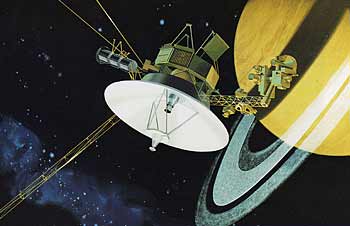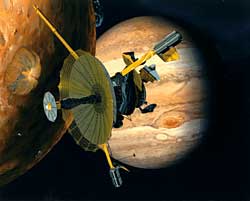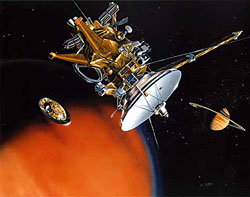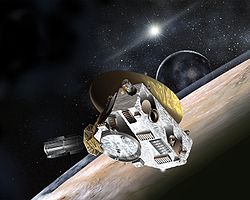Planetary Probes
- Mercury
- Venus
- Mars
- Outer Planets
- Satellites
Space Probes
OUTER PLANETS PLANETARY PROBES
 PIONEER 10 & 11
PIONEER 10 & 11
Pioneer 10 was the first spacecraft to penetrate the asteroid belt between Mars and Jupiter and travel to the outer regions of the solar system. It returned the first close-up pictures of Jupiter, measured the temperature of Jupiter's atmosphere, and mapped its magnetic field. Pioneer 11 flew past Saturn and its moon Titan in 1979 during which the first close-up images of that planet and its rings were radioed to Earth.
 VOYAGER 1 & 2
VOYAGER 1 & 2
Pioneer 11's visit to Jupiter was followed by those of Voyager 1 and 2. In 1986, four and one-half years after visiting Saturn, Voyager 2 made the first close-up survey of Uranus. The Voyager 2 mission provided more information about Uranus and its moons than had been gathered since the planet's discovery. Uranus was previously thought to have nine rings. Voyager 2 revealed 11 rings. Voyager 2 completed its 12-year tour of the solar system with a visit to Neptune and its moons.
 GALILEO
GALILEO
In 1989, Galileo was launched to examine Jupiter and its four largest moons. Galileo has transmitted images of Jupiter's moon Europa, which indicate that water may have existed, and might still exist, beneath Europa's crust. Other Galileo findings include new information about Jupiter's Great Red Spot and images of an eruption on Jupiter's moon Io. The probe took samples of Jupiter's atmosphere.
 CASSINI
CASSINI
On October 15, 1997, the plutonium-powered Cassini probe began what is anticipated to be a seven-year, two billion-mile voyage to Saturn. Cassini is the largest, most complex and most expensive interplanetary probe launched to date. The mission of the two-story robotic explorer is to provide NASA scientists with information about Saturn, its rings, and moons during the four years it is scheduled to orbit the planet.
 NEW HORIZONS
NEW HORIZONS
The New Horizons space probe was launched on January 19, 2006 and is currently en route to do the first flyby of Pluto (July 2015) and eventually several other Kuiper Belt objects (2016-2020). On its way to the outer rim of our solar system, New Horizons has already imaged several of our more familiar planets and provided us with some very useful information. The hope is that with this mission, we can get a better look and understanding of what lies just beyond our planet Neptune.